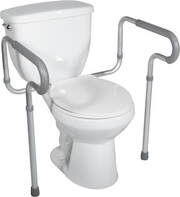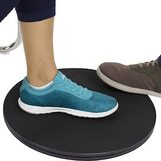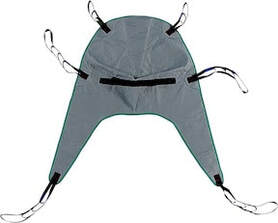HOME & DAILY LIVING GUIDE
|
There are many transfer devices that can help you move safely from place to place, with and without caregiver assistance. Transferring, or moving from place to place, becomes more difficult as the disease progresses and you lose muscle strength. Moving between chairs, getting on and off the toilet, and moving from the bed to a walker or wheelchair can become challenging for both for the person living with ALS and the caregiver. |
|
|
If you are struggling with any type of transfer, ask the physical therapist (PT) or occupational therapist (OT) at your ALS Clinic or home health agency for suggestions. There are many different assistive devices and strategies that can help you move safely from place to place.
|
|
Transferring Safety
|
The most important thing about transfers is making sure you and your caregiver do them safely. Preventing falls and injuries must be the top priority when determining which devices and techniques will work best for you.
It is also important to recognize when a transfer method that used to work no longer does. If it feels like your transfers are becoming less safe, reach back out to your PT or OT to restrategize and discuss which transfer devices and techniques will be best moving forward. Contact your neurologist if you think you could benefit from transfer training in your home. |
|
Independent Transfers
|
If you are starting to have trouble standing up, there are assistive devices and techniques that may be able to help you continue to get up and down on your own.
For starters, try raising your seat heights so that your hips are above your knees. This will give you a mechanical advantage that makes it easier to stand up while using less energy. |
|
|
You can try adding solid cushions, foam blocks, or even patio cushions to raise your chair heights at home, but do not stack multiple cushions as they can slide or tip. You can also add furniture risers under your sofa, if possible, to raise its overall height to make it easier to get up. If you have arm strength, you can use chair armrests, a transfer pole, or a walker to help you stand. If your walker has wheels, be sure to lock them first.
|
|
|
If you need an additional boost, an uplift seat can actively help get you to a standing position. Uplift seats must be used on firm surfaces and may not be comfortable for long periods of sitting.
|
|
|
A swivel seat cushion is a device that helps make transfers easier by spinning you to the left or the right. If your legs are weak, someone may need to help move your legs as your body turns. Swivel seats are particularly helpful for getting in and out of cars.
|
|
|
The popular, motorized lift chair recliner can help you move between reclining, sitting, and lifted positions. Many people living with ALS find lift chair recliners comfortable and helpful for transferring.
|
|
Toilet TransfersMany of the same principles apply when getting on and off the toilet. Devices like toilet safety frames can help you stay independent in the bathroom. Visit our Toileting page to learn more.
|
Assisted Transfers
If you can still use some of your own arm and leg strength and need help from a caregiver, you will need to learn how to safely transfer with assistance. There are many different types of transfers, so you will need to use different methods and devices depending on your particular situation.
It is important to keep in mind variables such as the size and strength of the caregiver in relation to the size and strength of the person being transferred. If a caregiver feels that transfers are uncomfortable or unsafe without additional assistance, you will either need a second caregiver or a patient (Hoyer) lift.
It is important to keep in mind variables such as the size and strength of the caregiver in relation to the size and strength of the person being transferred. If a caregiver feels that transfers are uncomfortable or unsafe without additional assistance, you will either need a second caregiver or a patient (Hoyer) lift.
|
If you need transfer assistance, you should use a gait belt or transfer belt so the caregiver has something secure to grasp. Caregivers should not grab arms, clothing, or belt loops during transfers.
|
|
|
If you can stand with assistance but have trouble lifting or turning your feet, a pivot disc can help you slowly rotate 90 or 180 degrees before sitting down again on a chair, wheelchair, or toilet.
|
|
|
Another way to move from one seated position to another is by using a transfer board. This simple board becomes a bridge between where you’re seated and where you’re going. You can scoot across the board with or without assistance.
|
|
|
If scooting across a transfer board is challenging, you can try a Beasy Board, which is a transfer board that has a gliding, rotating seat that helps minimize lifting, tugging, and twisting.
|
|
Lift chair recliners and power wheelchairs can also help with assisted transfers by mechanically raising you up and tilting you forward so that you’re already closer to a standing position.
Other than Medicare paying for part of a motorized lift chair recliner, most transfer devices are not covered by insurance. Ask your ALS clinic or local ALS organization if you can borrow transfer devices at no cost from their equipment loan closet. You can also visit our Transfer Devices page to learn more and purchase them directly.
Other than Medicare paying for part of a motorized lift chair recliner, most transfer devices are not covered by insurance. Ask your ALS clinic or local ALS organization if you can borrow transfer devices at no cost from their equipment loan closet. You can also visit our Transfer Devices page to learn more and purchase them directly.
Equipment Loan ClosetsYou can potentially save thousands of dollars by borrowing equipment from ALS loan closets. Many local ALS organizations and clinics loan certain types of assistive devices and medical equipment at no cost. Learn more |
|
Tips for Assisted Transfers
- Prepare the destination. Limit the distance of the transfer and remove any potential hazards. Lock wheels on walkers, wheelchairs, and rolling chairs.
- Don’t rush. When possible, give yourself the time you need to transfer so that nobody feels rushed. Try to be patient.
- Develop a plan. Before transferring, have a system in place so everyone is on the same page. Count to three and then move together.
- Start higher when possible. Transfers will be easier when the person is sitting higher. A raised toilet seat, chair cushion, or lifted recliner can make transfers easier.
- Use a gait/transfer belt. Make sure you have a secure place to hold. Do not grab onto the person’s clothing, belt loops, or arms.
- Stand close. The caregiver should stand close to the person being transferred, often in front and a little to the side. Leave room for the person to stand and face the transfer destination.
- Widen your stance. For greater stability, caregivers should start with feet wider than hip distance apart.
- Bend with your knees. For greater power and to prevent back injury, caregivers should bend at the knees and use leg strength.
- If it’s not going well, stop. If you are struggling in the middle of a transfer, stop and go back to where you started. Reevaluate and either try again or use a different method.
- Conserve energy. Transfers can be exhausting and time-consuming. When possible, try to think ahead so you can avoid any unnecessary transfers.
Every transfer situation is different. These are general tips—not step-by-step instructions. Always consult with and get training from your physical or occupational therapist.
Transferring with a Patient (Hoyer) Lift
|
If you are unable to help bear your own weight and your caregiver(s) cannot safely lift you on their own, you will need to transfer using a patient lift (commonly called a Hoyer lift). While you are seated or lying in a sling, this very helpful device lifts and transfers you between your bed, wheelchair, recliner chair, etc. Should you ever fall, your patient lift can also help lift you off the ground.
There are also sit-to-stand lifts, which can help transfer you from one seated surface to another, but these lifts are only helpful if you have some mobility but lack the strength or muscle control to rise to a standing position on your own. When you receive your patient lift, your neurologist should arrange for a PT or OT to come to your home to train you. Learning to use a patient lift can be tricky, so you may also want to practice on someone else until you feel comfortable with it. |
|
|
Patient lifts have wheels, so theoretically you could roll from place to place while the person is sitting in the sling. However, it can be hard to roll patient lifts across carpet or over rugs or thresholds. Patient lifts are also big and wide, so they may not fit through doorways or inside bathrooms.
Depending on your daily routine and home accessibility, there are multiple ways to use a patient lift. If your bathroom is accessible, you have no clothes on, and are in a divided-leg mesh sling, you could transfer from your bed into the lift, roll over the toilet to use it, and then roll straight into the shower. If the lift won’t fit in your bathroom, you could transfer to a bedside commode chair, or transfer to a rolling shower-commode chair and then enter the bathroom. |
|
|
Therapists often recommend a divided-leg sling, also known as a U-shaped sling, for people living with ALS because it can be slipped behind and under the person without having to lift them all the way up. Divided-leg slings also leave an opening below so that you can relieve yourself while still in the sling. Full slings can be helpful if you are connected to a ventilator and cannot sit fully upright.
Full and divided-leg slings come in mesh, which is best for getting wet in the shower. Slings come in different sizes and should be ordered with a head support, when possible, for both comfort and support. Patient lifts can be operated by one caregiver, though it may be challenging if the person in the lift is much bigger than the caregiver. You may need two people if the person being lifted is on a ventilator. There are both manual and electric patient lifts. Manual lifts have smaller footprints and don’t need to be charged, but you will need to pump the hydraulic lift by hand. |
Divided-leg sling
Full sling
|
Ceiling lifts are another option that can be helpful for transferring, but they are less versatile and mobile than patient lifts and are not covered by insurance unless you are a military veteran receiving service-connected benefits.
There are some general transfer tips for patient lifts such as widening the base for stability, locking the wheels, and positioning the bar so it doesn’t hit the person in the head, but because every lift and situation is unique, be sure to get trained by a local professional. The video demo on this page should give you a good sense of how to use a patient (Hoyer) lift.
Ask your medical team when you might qualify for a patient lift. Most insurances will cover the manual lift but not the electric one. If you prefer an electric lift, ask the durable medical equipment (DME) company if you can just pay the difference between the manual and electric model. Sit-to-stand lifts are usually not covered by insurance.
There are some general transfer tips for patient lifts such as widening the base for stability, locking the wheels, and positioning the bar so it doesn’t hit the person in the head, but because every lift and situation is unique, be sure to get trained by a local professional. The video demo on this page should give you a good sense of how to use a patient (Hoyer) lift.
Ask your medical team when you might qualify for a patient lift. Most insurances will cover the manual lift but not the electric one. If you prefer an electric lift, ask the durable medical equipment (DME) company if you can just pay the difference between the manual and electric model. Sit-to-stand lifts are usually not covered by insurance.
Home Safety
You can learn more about bathroom safety, fall prevention, safety alert systems, and what to do in case of a fall on our Home Safety page.















